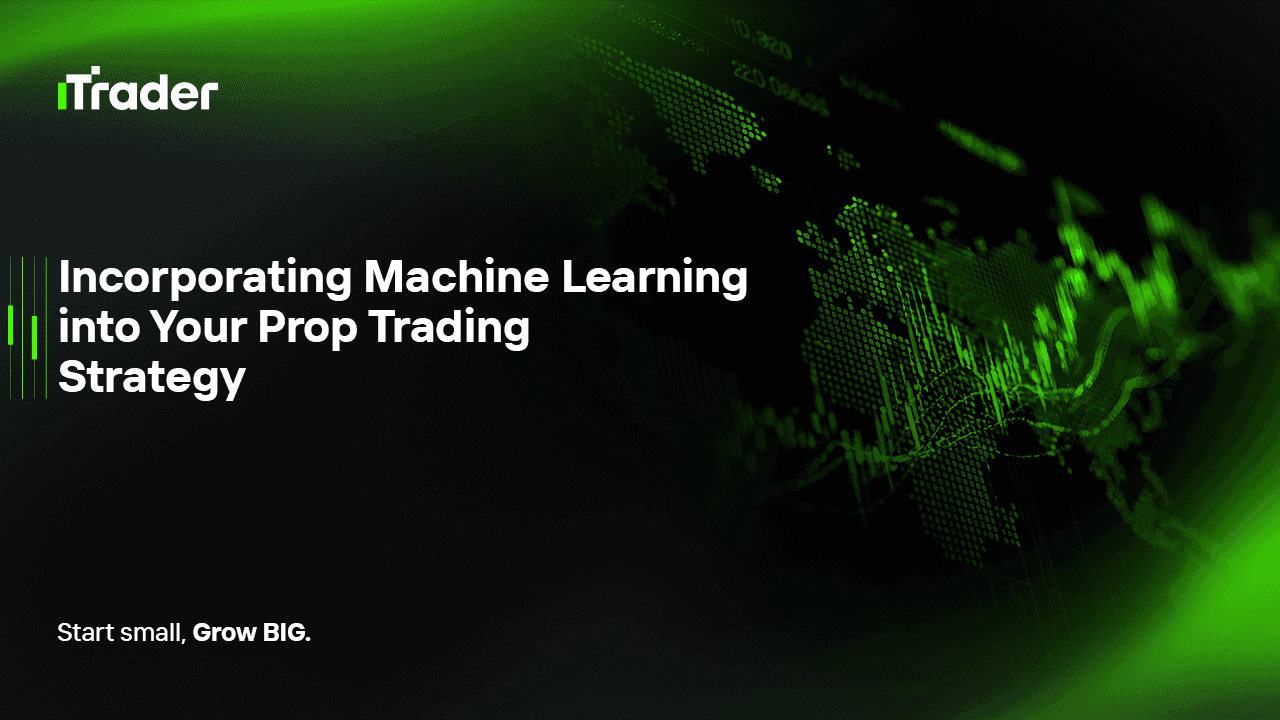2025-07-25
In forex market, the most successful traders are not those relying solely on intuition, but those who make decisions rooted in data, probability, and systems thinking. With the rapid evolution of financial technology, machine learning (ML) and artificial intelligence (AI) are becoming essential tools that help traders minimize cognitive errors, discover market patterns, and automate decision-making with precision. For proprietary traders—where performance consistency is vital—ML/AI offers a competitive edge by turning raw data into actionable signals.

AI Summary:
This blog explores how machine learning (ML) and artificial intelligence (AI) can be integrated into forex trading strategies, specifically tailored for proprietary traders. It walks through the strategic benefits of using data-driven models, practical applications such as regime detection and signal generation, and outlines a structured roadmap to deploy ML/AI in trading systems. The goal is to help traders increase adaptability, reduce emotional bias, and build robust systems that adjust with market conditions.
Artificial Intelligence (AI) refers to systems that mimic human decision-making and reasoning, while Machine Learning (ML) is a subfield of AI focused on algorithms that learn from data patterns and improve over time without being explicitly programmed. In trading, AI supports automation and adaptation, whereas ML is used to forecast prices, detect regimes, and generate signals based on learned patterns.
1. Pattern Detection Beyond Human Intuition
ML models can identify complex, nonlinear relationships that are often invisible to traditional indicators. These patterns are often scale-invariant and dynamic—ideal for high-volatility environments.
2. Real-Time Adaptation
As market conditions shift, ML models can retrain on new data and respond faster than rule-based systems, which often require manual reconfiguration.
3. Systematic Decision-Making
Machine learning helps eliminate emotional bias, enabling objective, repeatable strategies. It’s particularly effective when testing thousands of scenarios across multiple timeframes or instruments.
A. Direction Prediction
Supervised learning models such as logistic regression, random forests, and XGBoost can classify market direction based on features like moving average crossovers, RSI levels, and macro indicators. The output helps decide whether to go long, short, or stay neutral.
B. Signal Generation
Time-series forecasting techniques, including ARIMA, Prophet, and LSTM (a deep learning model), can be used to predict price movements and generate trading signals. When the model forecasts significant directional movement, it triggers trade entries or exits.
C. Regime Detection and Strategy Switching
Unsupervised learning methods help detect structural changes in the market—such as volatility spikes or trend exhaustion. Techniques like PCA and K-means clustering group similar market environments, allowing you to apply different strategies per regime.
D. Sentiment Analysis Using NLP
Natural Language Processing (NLP) allows you to extract market sentiment from social media, news feeds, or financial reports. Models like BERT or RoBERTa can analyze tone and context to forecast risk-on or risk-off behavior in the market.
1. Data Collection and Preparation
Start by gathering high-quality price data, macroeconomic indicators, and possibly text-based data. Clean and normalize the data to remove noise, fill gaps, and standardize formats.
2. Model Selection and Training
Choose an appropriate ML technique depending on your goal: supervised for prediction, unsupervised for clustering, or reinforcement learning for decision-making under uncertainty. Use cross-validation and regularization techniques to avoid overfitting.
3. Backtesting and Forward Testing
Apply your model to historical data using realistic trading conditions, including slippage, spreads, and execution delays. Use walk-forward analysis to simulate how your model performs in changing market environments.
4. Deployment into Live Trading
Integrate your model with platforms like MetaTrader via Python APIs or connect it to your broker’s execution system. Ensure the strategy includes real-time monitoring and alert systems to track performance and intervene if needed.
Advantages:
Challenges:
Proprietary firms are actively integrating ML/AI across several key areas:
While some firms hire quantitative researchers and data scientists to build complex models, others empower traders to construct semi-automated strategies using open-source tools and cloud-based infrastructure.
Explainable AI (XAI):
New frameworks are emerging to help traders understand why an AI model made a certain decision, improving trust and transparency.
Reinforcement Learning:
AI agents learn by receiving rewards or penalties for trading outcomes, making them ideal for complex environments like order flow prediction or multi-asset allocation.
Multi-Agent Systems:
Simulating market environments using multiple AI agents that compete or cooperate to discover emergent trading strategies.
Synthetic Data Generation:
Generative models like GANs are being used to create artificial price series for robust testing across unseen scenarios.
Machine learning and artificial intelligence are not magic bullets, but they can vastly improve the precision, consistency, and adaptability of your trading systems. For prop traders, where performance is everything, AI can help filter noise, reveal edge, and automate complex decisions. However, successful adoption requires a deep understanding of both markets and machine learning principles. Those who combine domain expertise with data science will be at the forefront of next-generation trading.
© 2025 iTrader Global Limited|公司註冊編號:15962
iTrader Global Limited 註冊於科摩羅聯盟昂儒昂自治島穆扎穆杜 Hamchako,並受科摩羅證券委員會授權與監管。我們的牌照編號為 L15962/ITGL。
iTrader Global Limited 以「iTrader」為商業名稱經營,獲得從事外匯交易活動之授權。公司標誌、商標與網站均為 iTrader Global Limited 之專有財產。
iTrader Global Limited 的其他子公司包括:iTrader Global Pty Ltd,澳洲公司註冊編號(ACN):686 857 198。該公司是 Opheleo Holdings Pty Ltd 的授權代表(澳洲金融服務代表編號:001315037),Opheleo 持有澳洲金融服務執照(AFSL 編號:000224485),註冊地址為:Level 1, 256 Rundle St, Adelaide, SA 5000。
免責聲明:本實體並非本網站所交易金融產品之發行者,亦不對其負責。
風險提示: 差價合約(CFD)交易因槓桿效應具高度資本迅速損失風險,未必適合所有使用者。
參與基金、差價合約及其他高槓桿商品交易,需具備專業知識。
研究顯示,84.01% 的槓桿交易者最終蒙受損失。請務必充分了解相關風險,並在投入資金前確保自身已準備好承擔全部損失的可能性。
iTrader 特此聲明,對任何個人或法人因槓桿交易所導致之風險、損失或其他損害,概不承擔全部責任。
使用限制: iTrader 並不向法律、法規或政策禁止此類活動的國家或地區居民提供網站或服務。如您居住於限制使用本網站或服務之司法管轄區,您有責任自行確保遵守當地法律。